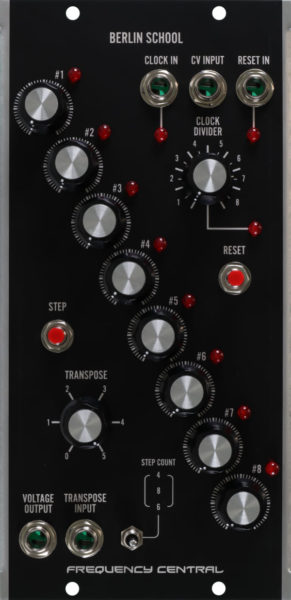Frequency Central has introduced Berlin School – a new step sequencer, inspired by German electronic music of the 70s, that’s available in both Eurorack and MU formats.
 Berlin School is based around a 16F1765 PIC controlling the classic CD4017 Johnson counter chip, which provides a few novel features:
Berlin School is based around a 16F1765 PIC controlling the classic CD4017 Johnson counter chip, which provides a few novel features:
- Onboard clock division: /1, /2, /3, /4, /5, /6, /7, /8 (integers)
- External voltage control of clock division
- Quantized output (chromatic)
- Quantized manual transpose (chromatic)
- Quantized voltage controlled transpose (chromatic)
- 4 step / 6 step / 8 step options
Frequency Central says that Berlin School is has several features tailored to interactive tweaking:
- You can externally control the length of each individual step via the DIV.CV input socket, by using another CV source, such as another Berlin School, an LFO, or even a sample and hold module – so any step can last for any clock length from 1 through to 8.
- You can externally control transposition of Berlin School via the TRANS.CV input socket, by using an external controller, such as another Berlin School (running at a slower speed), a 1V/oct keyboard (love this!), of any other CV source such as Little Melody for example.
- You can also do both of the above manually by using the DIV knob and the TRANSPOSE knob.
- You can change eaisily notes for each step in real time, since notes are quantized.
Pricing and Availability
Berlin School is available now in Euro format for £160.00, and in MU format for £275.00. DIY options are also available.

Skip steps?
Mute steps?
Ratcheting?
I don’t see any “Berlin School” in this module…..
“Skip steps?
Mute steps?
Ratcheting?
I don’t see any “Berlin School” in this module…..”
“Skip steps” is the only item that you mention that was actually a feature of the 960 step sequencer. It was a feature used in performance by TD & Michael Hoenig, but not by Klaus Schulze and other Berlin School artists.
This sequencer looks like it has everything you need to sequence in the style of Klaus Schulze. You might want to have two of them, so you could create two different patterns at the same time.
“Mute steps’ is a feature of gate sequencers, not voltage sequencers. Some modern sequencers, like the excellent Moon Modular sequencer, combine these ideas in one module.
Ratcheting can be done many different ways, but, again, wasn’t a feature of the Moog sequencer or any commercially available sequencer back then, to my knowledge.
I’d love to see a companion gate sequencer (‘Brandenberg Gate’ would be a great name) that would provide sync, reset, probability and ratcheting. These features aren’t really available in any inexpensive gate sequencer, and a module of this sort would be useful to anyone with an analog voltage sequencer.
This could be done compactly, following the model of the Moon Modular. You’d need 8 three-position toggles (Gate On, Gate Off, Function). Function would have another three-position toggle, which would allow you to chose between probability, reset and ratcheting, and a knob that would let you set the probability of the gate triggering or probability of ratcheting.